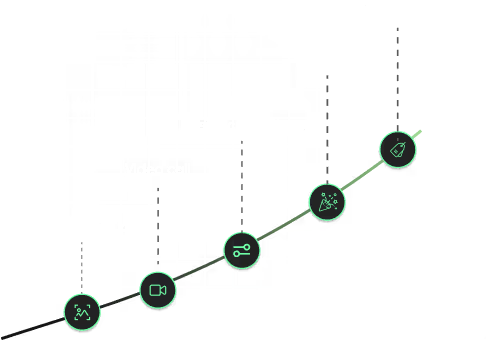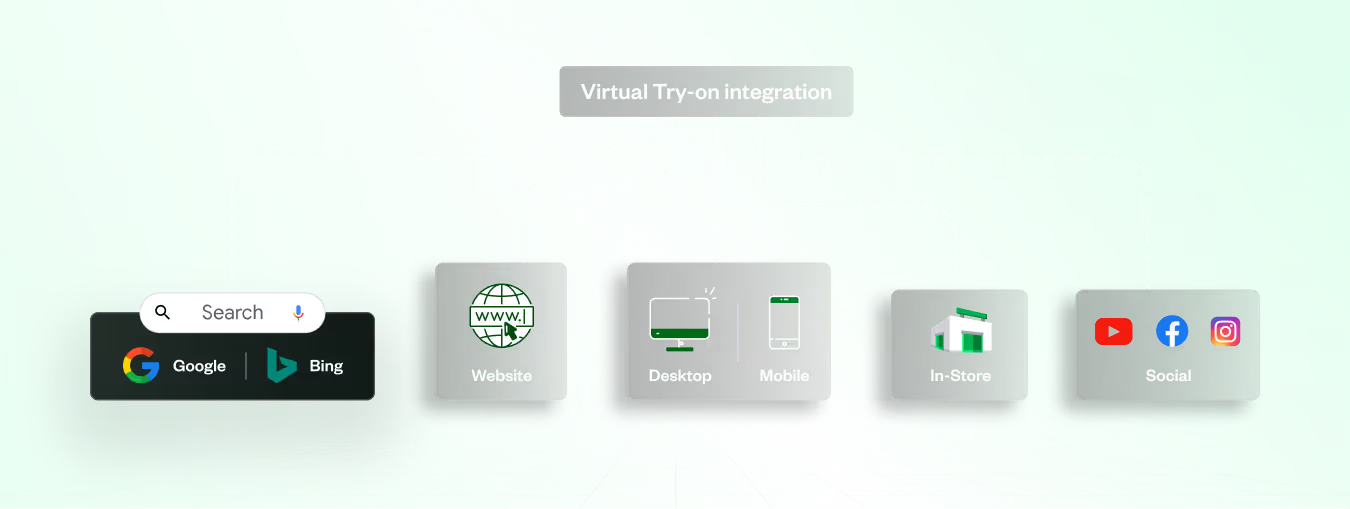7 Essentials For A Great Virtual Try-On Experience

Overview
In the dynamic and ever-evolving world of e-commerce and retail, the emergence of Virtual Try-on (VTO) technology marks a significant milestone. This innovation, driven by the rise of e-commerce and the integration of augmented reality (AR), is reshaping consumer interactions across various sectors, including fashion, apparel, cosmetics, beauty, jewelry, and watches.
Today's retail landscape is fiercely competitive, with fashion, beauty, and lifestyle brands constantly vying for consumer attention. Here, Virtual Try-on Tech provides the competitive edge. It transcends the traditional approach of merely listed products; instead, it provides an immersive, personalized shopping experience that resonates deeply with the tech-savvy consumer.
The shopping journey has evolved dramatically. Consumers now prefer to explore, assess, compare, and decide on their purchases through online channels. This shift has made the physical store visit an optional step at best, primarily for specific actions like trying out a product or checking availability.
In this context, the experience between the initial online exploration and the final purchase decision is crucial. It shapes brand perception, equity, and ultimately, sales success.

The State of Virtual Try-on Technology
Bridging the gap between digital exploration and physical purchase is where Virtual Try-on technology, leveraging augmented reality (AR), comes into play. VTO has revolutionized the online shopping experience, enabling customers to visualize products on themselves in a way that was previously unavailable. From trying on glasses virtually to experimenting with virtual hair color and cosmetics, brands are now offering consumers a way to see and feel products, enhancing their confidence in purchase decisions.
Explore the key aspects of the current virtual try-on technology, encompassing both its strengths and challenges.
The Positives
The implementation of VTO technology has yielded several notable benefits:
- From luxury to mainstream
VTO has enabled better purchase decisions for 61% of online buyers.
- Driving down return rate
Brands that offer a VTO have 64% less return rates then those which don’t.
- Proven conversion jump
Once implemented, a great VTO has potential to increase conversions by 2X or 94%.
- DIY In - Store solution
Implementing a VTO is best low-touch and hygienic way to try multiple products at the store.
The Challenges
Despite its advantages, VTO technology faces several challenges that need addressing:
- Non-intuitive design
8 out of 10 buyers find it difficult to navigate through VTO solutions, leading to drop-offs.
- Missing realism
78% of buyers drop-off using VTO due to lack of product realism on their face during try-on.
- Incomplete catalog coverage
Even on VTO-enabled websites, 60% of buyers are unable to try-on their choice of products.
- Lacking personalization
77% consumers have paid more for a personalized service or experience & VTO lacks them.
- Nothing for increasing AOV
VTOs of today lack upsell or cross - sell features.
The Evolution of the Smartphone Camera
The transformation of smartphone cameras has played a pivotal role in the rise of VTO. Today's cameras, equipped with AR capabilities, seamlessly integrate features like virtual makeup try-on and virtual eyeglasses try-on into the realm of e-commerce. This integration occurs effortlessly on social media platforms, where consumers spend a significant amount of time.

As smartphone cameras have evolved from simple image-capturing tools to sophisticated devices capable of supporting complex AR functionalities, the scope and capabilities of VTO technology have expanded significantly.

7 Essentials for a Successful Virtual Try-On Experience
In this section, we uncover the key elements that define a truly outstanding Virtual Try-on (VTO) experience, enabling brands to meet and exceed the evolving expectations of their customers in the digital retail landscape.
These points below aren't just theoretical ideas; they're practical, effective strategies informed by current tech trends and online consumer behavior. We'll outline the seven key components that we believe are crucial for crafting a VTO experience that not only appeals to today's tech-savvy shoppers but also adapts to their evolving shopping habits.
1. True-to-product Visualization for all

The success of a Virtual Try-on, be it for glasses, hair color, or makeup, hinges on its ability to provide a realistic representation. Technologies like augmented reality (AR) play a crucial role here. For instance, in a virtual make-up or hair color try-on, it's essential to present a true-to-life representation of the product material and encompass the full spectrum of shades, from maroon to gray. This ensures users can accurately visualize how the product will appear when applied.
2. Full Catalog Coverage

Providing a Virtual Try-on (VTO) for every product within the same category is critical, from glasses to makeup, be it lipstick, jewellery, or eyewear. However, the current practice could be improved, brand selectively implement VTO to only a portion of available SKUs within a product category, leading to an inconsistent customer experience.
3. Complete Buying Assistance

Assistance features are indispensable for an outstanding Virtual Try-on experience as they encompass a seamless journey from curating personalized catalogs to enabling informed buying decisions. With AI-enabled recommendations tailored to each customer's unique preferences, the experience is elevated. Additionally, the option to connect with beauty experts online for consultations, adds a personalized expert touchpoint, making the overall experience comprehensive and customer-centric.
4. Omnichannel Integrations
.avif)
Omnichannel integrations play a pivotal role in serving an exceptional Virtual Try-on experience by ensuring a seamless and consistent buying journey. Through the integration of Virtual Try-on across all channels, brands can ensure a centralized ROI measurement, enhancing the overall efficiency of their marketing efforts. Consistency is paramount, and whether customers engage with Virtual Try-on through a mobile app, in-store kiosk, website, search engines like Google or Bing, YouTube, or other discovery channels, a universal experience is maintained. Ultimately, a robust Virtual Try-on solution must adeptly cater to consumers on the specific channel where they are shopping or browsing for products, creating a cohesive and user-centric experience across diverse touchpoints. Ecommerce giants like Amazon have started to integrate a Virtual try-on experience in for product categories like eyewear and footwear.
5. Design that Consumers Love
.avif)
A great VTO should deliver more than just easy navigation; it should excel in user experience, enticing users to return, which ultimately leads higher lifetime values. Additionally, incorporating design elements similar to widely-used social media apps such as Instagram ensures a seamless familiarity for daily users. Brands need to carefully assess VTO solutions based on these key factors to ensure they not only meet but exceed consumer expectations.
6. Respecting Customer Choices
.avif)
Respecting customer choices is paramount for an exceptional Virtual Try-on experience. By offering diverse try-on modes, including live camera options and Virtual Try-on with photos, brands can offer various privacy preferences. Real-time product visualization with a live camera feed ensures dynamic and authentic experiences. Allowing users to upload their existing pictures for try-ons adds a personalized touch, respecting individual choices in engagement. Additionally, the ability to visualize products on consumers from all demographics and skin-tones further increases service breadth of the technology.

7. Freedom to Experiment

Offering customers the ability to experiment with diverse looks and product combinations boosts satisfaction and drives new product discovery. Serving customers with preset looks according to user profiles further improves the buying experience. Customers are further empowered by enabling them to create and save looks which promotes user-driven personalization. The focal point is the shift from visualizing individual products to enabling users to explore and create complete looks, a strategy that is bound to improve customer experience and sales.
Performance Metrics that Brands Must Track
A successful Virtual Try-On (VTO) experience hinges on an intuitive UX design that seamlessly guides users, ultimately driving tangible conversions. The goal is to create a user journey that not only captivates but also converts interested browsers into committed buyers.
A robust VTO solution should empower consumers to experiment with multiple products and looks, elevating the overall shopping experience. By facilitating a more personalized engagement, it should result in higher cart values and increased checkout amounts, contributing to a notable boost in Average Order Value.
The success of VTO solutions rests on user experience (UX) design principles that prioritize ease of customer usage. A well-crafted UX should not only attract customers initially but also create an environment that encourages repeated visits and sustained engagement. Achieving high customer retention and a substantial daily active user base is indicative of an effective VTO platform.
A key metric for a top-tier VTO solution is its ability to provide hyper-realistic visualizations of products. This realism empowers consumers to make well-informed purchase decisions, ensuring that the product they receive aligns closely with their virtual try-on experience. Minimizing discrepancies between online visualization and actual products significantly contributes to reducing return rates.
In the realm of Virtual Try-on, these metrics are indispensable. Businesses utilizing this technology must assess their performance against these benchmarks to ensure an optimal virtual shopping experience for consumers and achieve sustained success.
Summary
In summary, a standout Virtual Try-on (VTO) experience can to transform your smartphone camera into a true virtual mirror. It should include realistic and accurate product visualizations, comprehensive catalog coverage, AI-driven buying assistance, seamless omnichannel integration, user-friendly design, respect for customer privacy choices, and the freedom for users to experiment. By focusing on these key elements, brands can offer an immersive and personalized shopping experience that aligns with the expectations of modern consumers, enhancing customer engagement and increasing sales conversions.



.avif)

.avif)

.avif)






%202.svg)